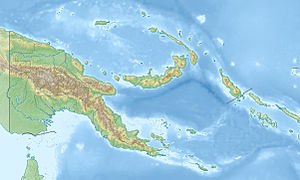Watom
| Watom | ||
|---|---|---|
| NASA satellite image from Watom. | ||
| Waters | Bismarcksee | |
| Archipelago | Bismarck Archipelago | |
| Geographical location | 4 ° 7 ′ 0 ″ S , 152 ° 4 ′ 0 ″ E | |
|
|
||
| length | 4.9 km | |
| width | 4.1 km | |
| surface | 13.2 km² | |
| Highest elevation | Tó hatut 351 m |
|
| Residents | 3398 (July 10, 2011) 257 inhabitants / km² |
|
| Vuatom on the German colonial map from 1910 | ||
Watom is an island in the Bismarck Archipelago and is located in northeast Papua New Guinea . Administratively it belongs to the Watom Island Rural Local-Level Government Area of the Province of New Ireland .
geography
Watom is 10 km northwest of Rabaul on the island of New Britain and 7.3 km from the northeast tip of the Gazelle Peninsula . The island is 4.9 km long and 4.1 km wide. It consists mainly of an extinct volcano 351 m high with a flat crater about one kilometer in diameter, pierced in the east. The island's steep limestone cliffs are covered in dense tropical rainforest .
On Watom, people from the Tolai tribe live in different villages. According to the July 10, 2011 census, the island had a population of 3,398, which was distributed among six villages as follows:
- Rakival (northeast) 352
- Taranata (northwest) 1153
- Valaur (southwest) 411
- Vunabuk (south) 326
- Vunakabai (southeast) 601
- Vunaulaiar (center) 555
history
The island has probably been in existence since around 1500 BC. Inhabited by Melanesians . Watom obsidian used to make tools and weapons was traded in the Talasea region of what is now West New Britain 2500 years ago . The area came under German administration in 1885 and belonged to German New Guinea since 1899 .
Otto Meyer, a Catholic clergyman, was the first to discover the Lapita culture in 1909 on Watom . Jim Specht explored the archaeological site in 1967, Dimitri and Roger Green from the Otago Museum in Dunedin and the University of Auckland in 1985.
During the First World War the island was conquered by Australian troops and after the war it was administered as a mandate of the League of Nations of Australia. From 1942 to 1944 it was occupied by Japan .
The Japanese occupation forces interned British prisoners of war on Watom. In January 1942 a contingent of 620 British soldiers (called: the Rabaul 600 ) was transported from Singapore to Rabaul. 21 surviving prisoners of war came to Watom in February 1944. In a valley near Tobera Airfield , Royal Australian Navy marines freed 18 survivors from the HMAS Vendetta on September 6, 1945. Watom returned under Australian administration as part of the Papua and New Guinea Territory in 1949 until Papua New Guinea gained independence in 1975.
Web links
- Watom Island Iceland, volcanic information (English)
- Heinrich Schnee (Ed.): Deutsches Kolonial-Lexikon, keyword Watom , Volume 2, p. 464, Leipzig 1920
- Topographic map sheet (detail)
Individual evidence
- ↑ Papua New Guinea National Statistical Office: 2011 National Population & Housing Census, Ward Population Profile, Islands Region
- ↑ Follow our dig! ( Memento of April 10, 2011 in the Internet Archive ) Otago Museum, Dunedin
- ↑ Peter Leggett: Watom Island British POWs


